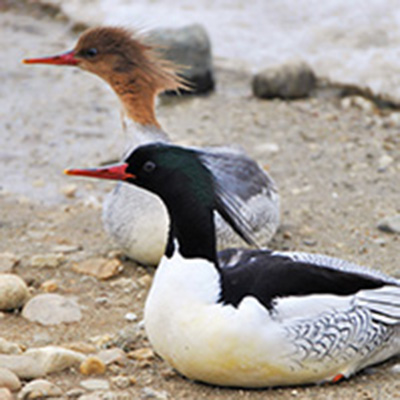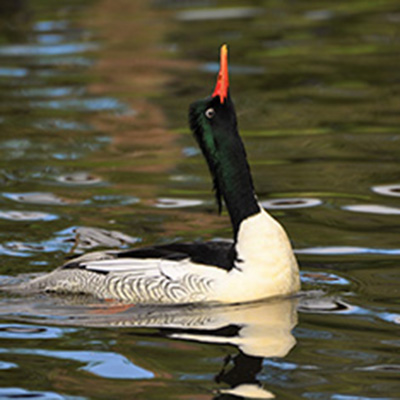Waterfowl: International Collaboration
In 2009, BRI began working with Dr. Diana Solovyeva and Dr. Sergey Vartanyan on studies and conservation of the imperiled wildlife in Arctic Russia. BRI received funding from the Trust for Mutual Understanding to support the continuation of this partnership and to create published materials on the endangered Scaly-sided Merganser (Mergus squamatus) for educational and research distribution in the United States, China, and Russia. In early 2016, Dr. Solovyeva and Dr. Vartanyan traveled from Russia to the United States to convene with BRI scientists in order to draft a scientific manuscript and outreach materials from field research findings that will aid in the conservation of the Scaly-sided Merganser.
Project Background

Since 2000, wildlife biologists from Russia and China have been studying the globally endangered Scaly-sided Merganser. This species has limited distribution and is found exclusively in isolated areas of Russia, China, and Korea. The decline of the worldwide population of the Scaly-sided Merganser and concern for its survival led to the formation of the Scaly-sided Merganser Task Force, dedicated to the conservation of the species.
Conservation Efforts

The overall health of Scaly-sided Mergansers and their ability to produce offspring seem to be impaired. Exposure to toxic chemicals is a potential factor harming the birds. In particular, rivers in China used by the Scaly-sided Mergansers on their wintering grounds are highly polluted with industrial contaminants. In June 2001, the Russian and Chinese governments reached an agreement aimed at preventing trans-border pollution in an effort to save endangered flora and fauna. In an effort to conserve the endangered Scaly-sided merganser, wildlife scientists identified the need to document and assess the severity of contaminant exposure and accumulation in this species.
Project Goals

One of the primary conservation goals of this project is for Russian, Chinese, and American scientists to further collaborate and create educational materials for display in local communities as well as to publish in peer-reviewed scientific journals, summarizing the concentrations of anthropogenic contaminants and their potential effects on the Scaly-sided Merganser. These materials will be shared with American, Russian, and Chinese wildlife conservation organizations, local communities, and governments, and would be highlighted on the Scaly-sided Merganser Task Force website. Educational outreach and publication of findings would provide materials for local communities to learn about the endangered Scaly-sided Merganser and provide guidance for the Chinese government to assess and further its goals to cease or reduce water pollution in order to save endangered flora and fauna.


